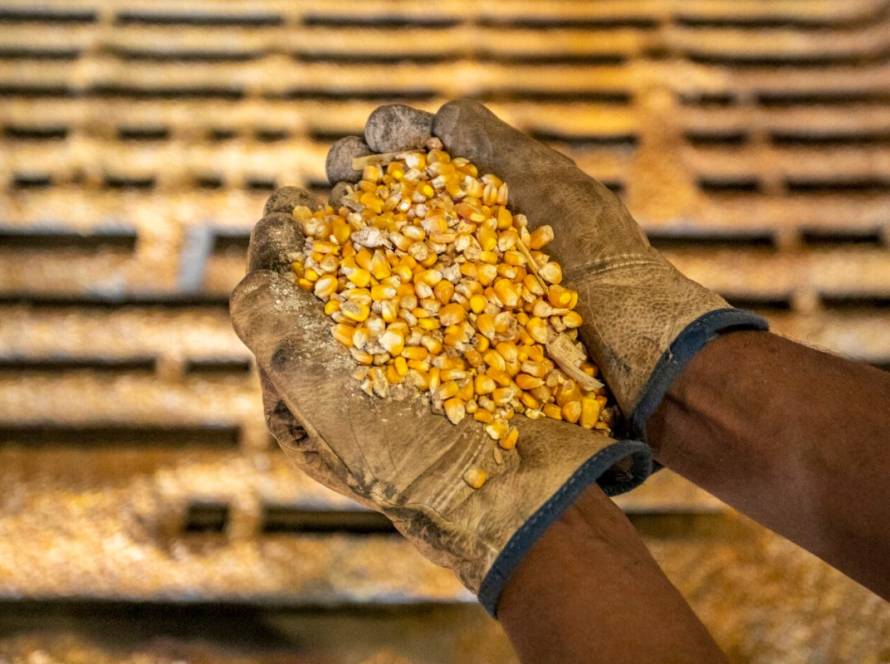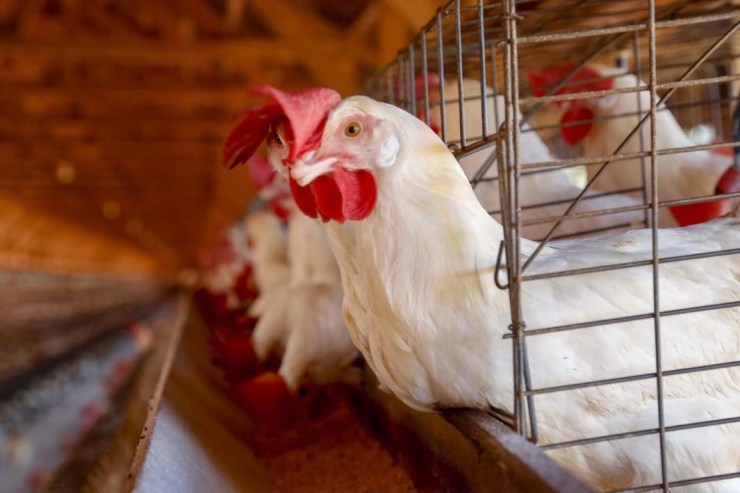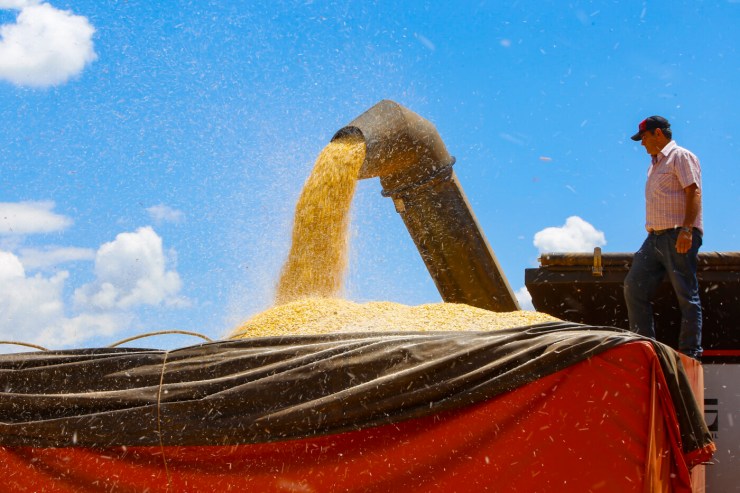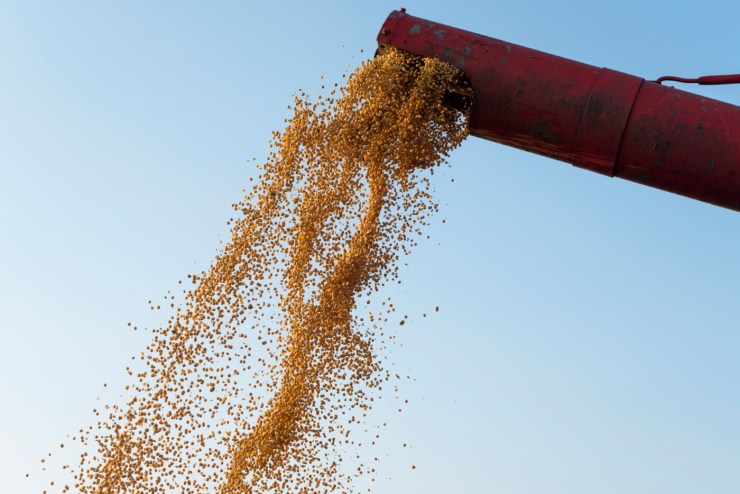After a season marked by high temperatures and irregular rainfall, corn production in the 2024/25 harvest is expected to grow. According to the latest estimate from the National Supply Company (Conab), the total harvest of the cereal is expected to reach 119.6 million tons, a volume 3.3% higher than the previous season, which was 115.72 million tons.
 Despite the positive forecast for total production, the first corn crop is expected to face a reduction of 6.4% in the planted area. However, the average productivity of the initial cycle tends to grow 4.8%, reaching 6,062 kilos per hectare. The harvest of the first crop is projected at 22.53 million tons. “This positive performance is linked to more favorable weather conditions, with frequent rainfall and sunny intervals, factors that boosted the development of the crop in the main producing regions”, says the farmer and president of the Brazilian Association of Corn and Sorghum Producers (Abramilho), Paulo Bertolini.
Despite the positive forecast for total production, the first corn crop is expected to face a reduction of 6.4% in the planted area. However, the average productivity of the initial cycle tends to grow 4.8%, reaching 6,062 kilos per hectare. The harvest of the first crop is projected at 22.53 million tons. “This positive performance is linked to more favorable weather conditions, with frequent rainfall and sunny intervals, factors that boosted the development of the crop in the main producing regions”, says the farmer and president of the Brazilian Association of Corn and Sorghum Producers (Abramilho), Paulo Bertolini.
Meanwhile, the sowing of second-crop corn has already exceeded 70% of the planting area and the weather conditions in the main producing regions are favorable for cultivation. And the third crop will be planted between April and June, predominantly in the states of Bahia, Sergipe, Alagoas, Pernambuco and Roraima. Bertolini emphasizes that the evolution of the crops will be decisive in confirming the projection of growth in the total production of the grain, especially considering the weather and logistical challenges that may arise throughout the production cycle.
Challenges faced in the 2023/24 harvest
The 2023/24 corn harvest was marked by difficulties, with high production costs and productivity losses due to adverse weather conditions, which led to a 12.3% drop in production compared to the previous cycle. Excessive rainfall in some regions and drought in others directly impacted crops. “In the Midwest, the lack of rainfall hampered the development of plantations, while in the South, excess water was the main problem,” says the president of Abramilho.
 In addition to climate challenges, logistical bottlenecks have compromised the flow of the harvest. “Corn competes directly with soybeans in the use of highways, railways and ports. And in this clash, corn is at a disadvantage, affecting the income of producers. Another limiting factor was the shortage of silos and warehouses, especially on farms, making it difficult to properly store the grain,” Bertolini points out.
In addition to climate challenges, logistical bottlenecks have compromised the flow of the harvest. “Corn competes directly with soybeans in the use of highways, railways and ports. And in this clash, corn is at a disadvantage, affecting the income of producers. Another limiting factor was the shortage of silos and warehouses, especially on farms, making it difficult to properly store the grain,” Bertolini points out.
Price fluctuations
Corn prices fluctuated significantly throughout 2024, influenced by factors such as climate, supply, demand and trade policies. However, despite a sharp drop in the first half of the year, prices recovered strongly in the second half of the year. The price of the grain fell by almost 20% compared to the end of 2023, but ended the year with an increase of approximately 5%.
In December, a 60 kg bag was quoted on average at R$ 72.70. Throughout the year, corn reached a minimum price of R$ 55.80 and a maximum of R$ 74.70 per bag. “At the end of 2024, there was a certain strengthening in values, however, high production costs and the drop in productivity directly impacted farmers' profitability. Therefore, our expectation for 2025 is an improvement in farmers' income and the growth of corn industrialization”, stated Bertolini.
Internal consumption
 Domestic corn consumption in Brazil is driven by the animal feed sector, followed by ethanol production, which has been growing year after year. The expansion of corn ethanol plants, especially in agricultural frontier areas, contributes to the liquidity of the grain and offers predictability to the sector.
Domestic corn consumption in Brazil is driven by the animal feed sector, followed by ethanol production, which has been growing year after year. The expansion of corn ethanol plants, especially in agricultural frontier areas, contributes to the liquidity of the grain and offers predictability to the sector.
Currently, around 70% of production is destined for the domestic market, while 30% is exported. In 2024, exports exceeded 39 million tons. With consumption close to 83.57 million tons, the final stock of the product settled at around 2.5 million tons.
Brazilian corn exports
According to the Secretariat of Foreign Trade (Secex), Brazilian corn exports in 2024 fell 28.8% compared to 2023, totaling 39.78 million tons in the accumulated period from January to December. Mato Grosso, the country's largest producer, accounted for 68% of this volume, with shipments of 27.03 million tons, a drop of 8.47% compared to the previous year. The decline in exports is associated with the lower supply of the grain in the 2023/24 harvest, especially in the second half of the year.

Photo: Claudio Neves
According to Itaú BBA's Agro Radar, the main reason for this decrease in cereal shipments was the reduction in Asian demand, with emphasis on the markets of South Korea, China and Japan. “For much of 2024, corn prices in Brazil were above export parity, which made the product less competitive compared to American corn. On the other hand, the African market registered a significant increase in demand, doubling the amount imported from Brazil, with emphasis on Egypt, which became the largest destination for Brazilian cereal, buying 14% of the total exported. The volume of exports to the Arab country was 240% higher than in the previous year”, informs the consultancy's bulletin, citing that corn prices fell 16%, reaching US$ 202.6 per ton.
Exports to China and Japan plummeted 86.9% and 65.1%, respectively. On the other hand, Egypt and Iran increased their purchases, taking the lead among the cereal's destinations.
The sector's performance was also affected by the conflict between Russia and Ukraine, which altered the flow of exports to Asia and Europe. Ukraine, a traditional supplier of corn to these markets, saw its production and distribution capacity reduced, benefiting the three largest global exporters: the United States, Brazil and Argentina.
Global corn production

Photo: Claudio Neves
The United States Department of Agriculture (USDA) estimated in January 2025 that global corn production in the 2024/25 harvest should reach 1.214 billion tons. In the US, the harvest is expected to total 377.6 million tons, a decrease of 3.1% compared to the previous cycle. For Brazil, the projection is 127 million tons, an increase of 4.1%. In Argentina, production is expected to reach 51 million tons, an increase of 2%. And global exports are forecast at 191.4 million tons, a slight decrease of 0.3%. Final stocks may fall by 7.6%, reaching 293.3 million tons.
New opportunities
Bertolini revealed that the Brazilian government is also seeking to expand the market for DDG (a byproduct of ethanol production). This is largely due to the increase in corn ethanol production in the country, which reached 7.2 billion liters in the 2023/24 harvest, with projections of up to 8 billion in the current season. “The outlook is that by 2025 the number of corn biorefineries in Brazil will double, which currently has 22 in operation. As a result, the supply of byproduct should increase both for the domestic and foreign markets,” predicts the president of Abramilho.
National production of DDG was 3.5 million tons in 2024, an increase of 22.1% compared to the previous year. Used in animal feed, exports of the input grew 26.7% last year, reaching 797.2 thousand tons, with the main destinations being Vietnam, New Zealand and Spain.
The National Corn Ethanol Union (Unem) projects that Brazil will produce around four million tons of DDG in the 2024/25 harvest, with an expected export of between 800,000 and one million tons. “In addition to strengthening the biofuels sector, this growth in national DDG production will expand opportunities for corn producers,” Bertolini stressed.
Brazil could become the country of corn

President of the Brazilian Association of Corn and Sorghum Producers (Abramilho), Paulo Bertolini: “Brazil has the potential to consolidate itself as a major producer and exporter of industrialized corn, as long as it can advance in infrastructure, storage and logistics” – Photo: Disclosure
The accelerated pace of corn ethanol production could consolidate Brazil as a global powerhouse in the cereal. According to Bertolini, if the growth of the biofuels industry continues at this pace, Brazil could increase its share of the international market, add value to the production chain and reduce its dependence on fossil fuels. The forecast for the 2024/25 harvest is an increase of 25% in corn ethanol production.
Unem projects growth of 40 billion tons over the next 10 years, but Bertolini draws attention to structural challenges. “Progress is needed in logistics, with improvements to highways, waterways and ports, in addition to modernization within the farm gate, especially in grain storage,” he points out, adding: “The growth in static storage capacity in Brazil is not keeping pace with the growth in corn production, which could lead to a logistical collapse in the short term after the harvest, a scenario that makes it even more important to increase investments in infrastructure to avoid bottlenecks in the flow and storage.”
In addition to ethanol and animal feed production, the president of Abramilho says there is room to expand the industrial use of corn, increasing the added value to the production chain. “The cereal can be used in the manufacture of biodegradable plastics, starch for paper and packaging, among other applications. But for this to happen, it is essential that Brazil expands domestic processing, reducing dependence on the export of raw corn and strengthening the local industry,” Bertolini points out, emphasizing: “Brazil has the potential to consolidate itself as a major producer and exporter of industrialized corn, as long as it can advance in infrastructure, storage and logistics.”





